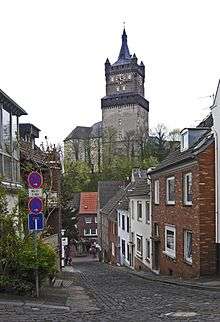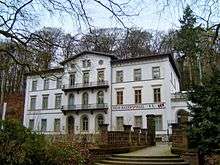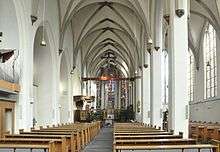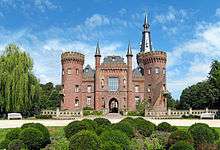Kleve
Kleve (Cleves,Kleff) is a town and a district (Kreis) in the Lower Rhine region of Western Germany.

Understand
Kleve (formerly spelled Cleves) used to be the capital of an eponymous County, and later Duchy, that existed from c. 1020 until 1795. From 1609 on, it was ruled in personal union by the Prince-Electors of Brandenburg who later became the Kings of Prussia. During the 17th century, it was one of three residences of Brandenburg-Prussia (besides Berlin and Königsberg). After being occupied by France for 20 years, it was annexed to the Prussian Rhine Province in 1815. Thanks to its mineral springs, Bad Cleve was a popular spa town from the mid-18th century until the spring dried up in 1914. Nowadays, the town of some 50,000 inhabitants is a county seat and member of the Dutch-German Euregio Rhine-Waal.
Get in
By plane
- 🌍 Weeze/Niederrhein Airport (NRN IATA) (30 km south of Kleve). The nearest airport, is mostly used by low-cost carriers like Ryanair. From the airport you get to Kleve by bus and train within 35 minutes. Alternatively, you may take a taxi for c. 55 €.
A major airport with more international connections is in Düsseldorf (DUS IATA), from where trains take you to Kleve in about two hours (you will have to change at Düsseldorf main station).
Another alternative is to fly to the Dutch airport of Eindhoven (EIN IATA), which is about 90 km west of Kleve (however, there is no convenient connection with public transportation).
By train
The 🌍 Train station. is served by regional trains to/from Düsseldorf via Krefeld every half hour. For destinations farther away, a change of train in Düsseldorf is probably necessary
By bus
From Nijmegen in the neighbouring Netherlands, there are hourly buses to Kleve (taking about 50 minutes from one central station to another). You may transfer in Nijmegen when arriving from Arnhem (1:15 hours to Kleve in total), Utrecht (two hours) or Amsterdam (2:45 hours).
By regional buses you may get to Kleve from Kalkar (25 minutes), Emmerich (half an hour) or Xanten (40 minutes).
Get around
See
.jpg)


- Kleve stands out with its extensive parks and gardens, dating back to the Baroque era. They were created during the governorship of Johann Moritz of Nassau-Siegen by the Dutch landscape gardener Jacob van Campen, starting in 1647. At the era, they enjoyed Europe-wide fame and were used as a model for other famous parks, including the gardens of Potsdam. The most original part is the 🌍 Neuer Tiergarten ("new game garden"). for which an artificial hill, called Springenberg, was raised. On the hilltop is an obelisk, on the hillside a decorative amphitheatre, and at its foot there is another park marked by a long body of water. The neighbouring 🌍 Forstgarten ("forest garden"). is an arboretum with several different tree species. The grounds are surrounded by a narrow moat, designed to prevent cattle or trespassers from entering without disrupting the view (as a wall or fence would have done). Finally, there is the Alter Tiergarten with Prince Johann Moritz's sepulchre (on Uedemer Straße near Bedburg-Hau, 3.5 km southeast of downtown Kleve), consisting of a cast-iron tumba and exedra, which is however empty as the Prince was eventually buried in Siegen rather than in Kleve.
- 🌍 Schwanenburg. Kleve's main landmark was begun in the 11th century as a spur castle, but later transformed into a more comfortable and representative Baroque residence. Its most characteristic item is a weather vane in form of a swan (heraldic animal and crest of the Dukes of Cleves), hence the name. It houses the Kleve district court, a geological museum, showing mineralogical and paleontologic exhibits from the Lower Rhine area, as well as a photo exposition.
- 🌍 Museum Kurhaus Kleve. Art museum with collections of works by Rhineland artists Ewald Mataré and Joseph Beuys, medieval, Renaissance and Baroque works, as well as pieces of contemporary art, graphics and applied arts.
- 🌍 B.C. Koekkoek-Haus. Collection of paintings by Barend Cornelis Koekkoek, who used to live in this house with his family, as well as other Dutch romantic artists of his circle.
- 🌍 Unterstadtkirche (St Mary of the Immaculate Conception). Very modest Gothic hall church without a steeple, that used to be the monastic church of a Minorites monastery.
- 🌍 Stiftskirche (Church of the Assumption of Mary). Kleve's Gothic, three-aisled main parish church.
- 🌍 Kleine Evangelische Kirche (Trinity Church). Small Lutheran church in the predominantly Catholic town, consecrated in 1621.
- 🌍 Alte Kirche Kellen (St Willibrord's Church). Romanesque church dating back to the 11th century, in the suburb of Kellen, 2.5 km northeast of the city centre.
Do
Buy
Eat
Drink
Sleep
- 🌍 The Rilano Hotel Cleve City, Bensdorpstraße 3, ☎ +49 2821 74946437.
- 🌍 Best Deal Airporthotel Weeze, Flughafen-Ring 17, 47652 Weeze, ☎ +49 2837 665577.
Connect
Nearby

- Schloss Moyland, Bedburg-Hau (9 km southeast of Kleve). Romantic watercastle that gets close to the prototype of a fairytale castle.
Go next
- Emmerich am Rhein, 12 km to the northeast on the opposite bank of River Rhine (25–30 minutes by bus)
- Nijmegen, Netherlands, 25 km to the west (50 minutes by bus)
- Kevelaer, 30 km to the south (25 minutes by train)
- Xanten, 30 km to the southeast (40 minutes by bus)
- Arcen, village near Venlo on the Maas river with a castle and beautiful gardens, 40 km to the south